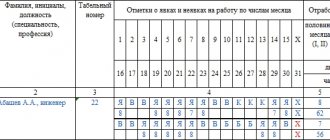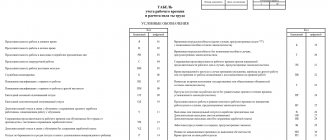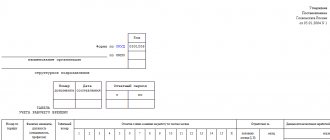What is a timesheet and why do you need to record time worked?
According to the standards, the obligation to maintain a time sheet is established by Resolution of the State Statistics Committee dated January 5, 2004 No. 1. The document helps the personnel service and accounting department of the enterprise:
- take into account the time worked or not worked by the employee;
- monitor compliance with the work schedule (attendance, absence, lateness);
- have official information about the time worked by each employee for calculating wages or compiling statistical reporting.
It will help the accountant confirm the legality of accrual or non-accrual of wages and compensation amounts for each employee. The HR officer must track attendance and, if necessary, justify the penalty imposed on the employee.
It is worth noting that the unified forms of report cards No. T-12 and No. T-13 are not required for use from 01/01/2013. But employers are required to keep records (Part 4 of Article 91 of the Labor Code of the Russian Federation). Organizations and individual entrepreneurs have the right to use other methods of monitoring the time employees spend at work. But in fact, the form format developed by Goskomstat is quite convenient and continues to be used everywhere.
Filling out and processing timesheets
The timesheet form for recording working hours worked is drawn up by an authorized person in one copy. It contains data on the employee’s actual attendance at work or absences from the workplace, shortened working hours, and so on.
If necessary, it is allowed to add a number of columns to display additional criteria. Work time costs can be shown on time sheets by recording only absenteeism with reasons.
Report sheet forms can be produced using modern printing technology. In this case, some of the details may already be filled in, for example:
- structural division of the company;
- Full name of the employee;
- profession and specialty of the employee;
- Personnel Number.
This is information that is classified as permanent and therefore rarely subject to change. Based on the completed timesheet, wages are calculated, compliance with working hours by staff is monitored, and statistical reporting is compiled.
In addition, the form serves as the basis for inspection by labor safety inspectorates - on the basis of it they look to see whether there have been any violations of the permissible working hours and violations of labor legislation in general.
Failure to fill out the report card correctly will result in fines for management in the amount of 1000-5000 rubles, and for the enterprise itself in the amount of 30-50 thousand rubles (Article 5.27 of the Code of Administrative Offenses).
The timesheet is filled out, as mentioned above, by an authorized person, and signed by the employee responsible for personnel records and the head of the structural unit. After this, the document is sent to the accounting department for payroll processing.
Time worked in the company on holidays is reflected using special codes. For going to work on such days, the employee is entitled to double pay, as well as an additional day for rest.
In report cards, such situations are marked with the coding РВ.
Who is responsible for recording time worked in the organization?
According to the instructions for using and filling out forms of primary accounting documents:
- the working time sheet is compiled and maintained by an authorized person;
- the standards indicate who signs the time sheet - the head of the department and the HR employee;
- after which it is transferred to the accounting department.
Management has the right to appoint anyone to perform this task. To do this, an order is issued indicating the position and name of the responsible person. If an order to appoint such an employee is not issued, then the obligation to keep records is specified in the employment contract. Otherwise, it is unlawful to require an employee to keep records. In large organizations, such an employee is appointed in each department. He fills out the form within a month, gives it to the head of the department for signature, who, in turn, checks the data and passes the form to the personnel officer. The HR department employee verifies the information, fills out the documents necessary for his work based on it, signs the time sheet and passes it on to the accountant.
In small companies, such a long chain is not followed - maintaining time sheets for employees is entrusted to the personnel employee, and he submits the completed document to the accounting department on a monthly basis.
Why do you need a time sheet?
The Labor Code of the Russian Federation establishes that every employer, regardless of its form of ownership, must keep records of the hours worked by its employees.
For the lack of timesheets, administrative penalties are provided for both the organization itself and its responsible employees. A time sheet is a form that contains information about working days for each employee, as well as absences from work for good or bad reasons. It can be done in two ways:
- All data on the presence or absence of employees is maintained daily.
- Data is entered into the timesheet in case of deviation, i.e. in case of absence, no-show, lateness, etc.
Based on the information in this document, salaries are calculated for all company personnel. It allows you to monitor compliance with labor discipline, as well as the standard length of the working week, the duration of overtime work, and the performance of duties on weekends.
The legislation establishes a 40-hour week for a five-day job, and a 36-hour week for a six-day job. With summarized accounting, the norm may be violated; the main requirement is that it correspond to a certain amount for the reporting period, for example, a quarter.
When a company receives an inspection from the labor inspectorate, the main document they request is a work time sheet. It is also the main source for generating statistical reporting on labor and personnel.
What is the difference between forms No. T-12 and No. T-13
The two approved forms differ in that one of them (T-13) is used in institutions and companies where a special turnstile is installed - an automatic system that controls the attendance of employees. And the T-12 form is universal and contains, in addition, an additional section 2. It reflects settlements with employees for wages. But if the company conducts settlements with personnel as a separate type of accounting, section 2 simply remains empty.
ConsultantPlus experts discussed how to keep track of working hours. Use these instructions for free.
Differences between working time sheet forms
This important document is maintained on form T12 or T13. It is also possible to develop your own form if it contains all the necessary details (they are specified in Law No. 402-FZ).
The selected form can be attached as an appendix to the order for the enterprise.
If the organization does not automatically record the presence of personnel at the workplace, use the standard T-12 form.
With its help, opportunities are provided for monitoring the time worked by employees and recording payments made to them.
If you keep these indicators separately, you can fill out only the 1st section called “Working Time Accounting”. In this case, it will be an independent form.
Form T13 is used in those companies that have automatic control of personnel entry and exit using access control systems.
This allows you to reduce time costs for accounting, and the T13 form is better suited for these purposes, since it does not provide for the display of wage data.
The timesheets of both forms contain columns that require mandatory data entry. This is the number of appearances at the workplace or absences, indicating the reasons for absence, information about overtime or overtime, information about business trips and downtime in the production process.
It is on the basis of the Accounting Sheet that wages are calculated for each employee.
For this purpose, tariff rates are used according to the salary grid. At the same time, the actual number of hours worked is taken into account.
Employees of auxiliary types of production, as well as company managers, are subject to time-based wages.
The same situation occurs in the case of payment for part-time workers. But with the piecework form of remuneration, remuneration is calculated on the basis of a payroll sheet, work order, route sheets and other similar forms.
Due to the variety of opportunities provided for remuneration, each accounting department can choose one or another form of employment and payment for a certain category of personnel.
Step-by-step filling instructions
Two rules apply for filling out a time sheet, the choice is made by the employer:
- continuous filling - all appearances and absences are recorded every day;
- filling in by deviations - only lateness and no-shows are noted.
Here are instructions on how to keep a time sheet manually - for the T-13 form using the continuous filling method.
Step 1. Name of the organization and structural unit
At the top, enter the name of the company (full name, individual entrepreneur) and the name of the structural unit: for example, sales department, marketing department, production department, etc.
Step 2. OKPO code
OKPO - All-Russian Classifier of Enterprises and Organizations. Contained in Rosstat databases, it consists of:
- 8 digits - for legal entities;
- 10 digits - for individual entrepreneurs.
Step 3. Document number and date of preparation
The document number is assigned in order.
The compilation date is usually the last day of the reporting month.
Step 4. Reporting period
The report card is submitted per month - the period from the first to the last day of June in our case.
Step 5. Employee information
A separate line is filled in for each department employee. Indicate the serial number, surname and position of the employee.
A personnel number is assigned to each employee and is used in all internal accounting documents. It is retained by the employee for the entire period of work in the organization and is not transferred to another person for several years after dismissal.
Step 6. Information about attendance and number of hours
Abbreviated symbols are used to fill out information about employee attendance and absence. You will find a list of them at the end of the article in a separate paragraph. In our example for employee Petrov A.A. 4 abbreviations used:
- I - attendance (in case of attendance, the number of hours worked is recorded in the bottom cell);
- On a weekend;
- K - business trip;
- OT - vacation.
Step 7. Total number of days and hours for the month
Here's how to correctly count hours on an organization's time sheet:
- in the 5th column indicate the number of days and hours worked for every half month;
- in the 6th column - the total number of days and hours for the month.
Step 8. Payroll information
The payment type code determines the specific type of cash payment, encrypted in numbers. For a complete list of codes, see the end of the article. The example uses:
- 2000 - salary (wages);
- 2012 - vacation pay.
Corresponding account is an accounting account from which costs for a specified type of remuneration are written off. In our case, the account for writing off salaries, travel allowances and vacation pay is the same.
Column 9 indicates the number of days or hours worked for each type of remuneration. In our case, the days of attendance and business trips are entered in the top cell, and the days on vacation are entered in the bottom cell.
If one type of remuneration (salary) is applicable to all employees during the month, then the code of the type of payment and the account number are written at the top, columns 7 and 8 are left empty, indicating only the days or hours worked in column 9. Like this:
Step 9. Information about the reasons and time of absence
Columns 10-12 contain the code for the reason for absence and the number of hours of absence. In our example, the employee was absent for 13 days:
- 3 days - due to a business trip;
- 10 days on vacation.
Step 10. Signatures of responsible persons
The report card is signed at the end of the month:
- employee responsible for maintenance;
- head of department;
- personnel worker.
Vacation notes
Before marking vacation on your time sheet, it is important to consider the following points:
- what type of leave to indicate;
- vacation period - from what date to what date the employee rests;
- what method is used to fill out the timesheet - continuous or only deviations are recorded?
Different types of leave are indicated by the following abbreviations:
| FROM | Another paid vacation |
| OD | Additional paid |
| BEFORE | Administrative (without saving salary) |
| U | Educational with salary retention |
| UV | On-the-job training (shortened day) |
| UD | Educational without saving salary |
| R | For pregnancy and childbirth |
| coolant | Child care up to 3 years old |
| OZ | Without saving the salary in cases provided for by law |
| DB | Additional without saving salary |
When using both methods of filling out a timesheet, a vacation symbol is affixed for each day the employee is absent. It’s just that when using the continuous method, the remaining days are filled with turnouts (conditional code “I”), and when using the deviation accounting method, they remain empty.
Other designations and codes
We present the letter designations used in the time sheet in the form of tables.
Presence at the workplace:
| I | Daytime work |
| N | At night time |
| RV | Work on weekends and holidays (used if the employee goes to work on days declared non-working due to quarantine |
| WITH | Overtime |
| VM | On a rotational basis |
IMPORTANT!
Remote and remote work is marked in the report card with the same symbols as regular work. If a remote employee has worked full time, indicate I (or 01 if indicated digitally) on the top line, and the number of hours actually worked according to the standard working time on the bottom line.
Business trips and advanced training:
| TO | Business trip |
| PC | Off-the-job training |
| PM | Advanced training with a break from work in another area |
Absence from work:
| B | Temporary disability (sick leave) with payment of benefits (also used if the employee is in quarantine) |
| T | Temporary disability without payment of benefits |
| Champions League | Shortened working hours in cases provided for by law |
| PV | Forced absenteeism due to illegal removal (dismissal) |
| G | Failure to appear in connection with the performance of state (public) duties |
| ETC | Absenteeism without good reason |
| NS | Part-time mode |
| IN | Weekends and holidays are non-working days (also included in cases where non-working days are established due to quarantine) |
| OB | Additional paid time off |
| NV | Additional unpaid day off |
| ZB | Strike |
| NN | Unexplained reason for no-show |
| RP | Downtime due to the employer's fault |
| NP | Downtime due to reasons beyond anyone's control |
| VP | Downtime due to employee fault |
| BUT | Suspension from work (paid) |
| NB | Disqualification without retention of salary |
| NZ | Suspension of work when a salary is delayed |
IMPORTANT!
If an employee goes to work on days declared by the president as non-working days due to the coronavirus quarantine (03/30-04/03/2020), it is recommended to enter the PB code in the timesheet indicating the hours worked.
We present only the main digital codes of types of remuneration (the full list is in the order of the Federal Tax Service of Russia dated October 13, 2006 No. SAE-3-04 / [email protected] ):
| 2000 | Labor payments (salary, remuneration) |
| 2010 | Payments under civil contracts |
| 2012 | Vacation pay |
| 2300 | Sickness benefit |
| 2530 | Payment in kind |
| 2760 | Financial assistance upon dismissal and retirement |
| 3020 | Interest on deposits |









